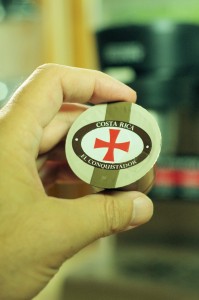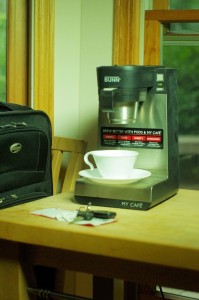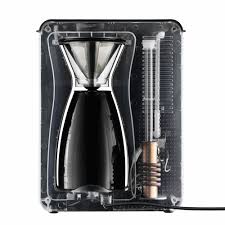by Coffee Kevin | Sep 9, 2014 |
 Recently, I reviewed every brewing format in the U.S. I freely admit I was previously strongly biased against pods in general and specifically the K-Cup, the number one pod format. My reasons weren’t simple connoisseur snobbery, but cool analysis based upon the following industry givens:
Recently, I reviewed every brewing format in the U.S. I freely admit I was previously strongly biased against pods in general and specifically the K-Cup, the number one pod format. My reasons weren’t simple connoisseur snobbery, but cool analysis based upon the following industry givens:
- Coffee must be brewed within two weeks from roasting.
- Drip coffee must be brewed over four-to-six minutes.
- Small batch, top-end roasted coffee isn’t available in K-cups.
Oh, and don’t forget this one:
- Anything too popular has to be bad.
With me so far? Good. Now, a few things happened since then to open my mind to at least the possibility that K-Cups might be a viable format. First, there is the Bunn My Café machine. In my tests this one machine was heads above the others in its ability to extract coffee. Keep in mind that for years Bunn has specialized in three-minute extraction through its almost-power-washing sprayhead design in traditional drip machines. The My Café gets the water up to industry-standard temperature heights and somehow (I’m not yet able to see into the brewing chamber) this results in a much better-than-average cup.
Second, the K-Cup patent expired. This means machinery entrepreneurs will be exploiting the format, perhaps even beyond what Bunn’s done (Bunn’s was developed through licensing prior to the expiration). The patent’s lapse also means a wider variety of coffee brands will be free to flood the market with K-Cups.
Third, new smaller-run K-Cup packaging machines have emerged to make it cost-effective for local roasters to make their own K-Cups. This has caused a virtual explosion. While some specialty roasters are still keeping their distance, several have announced top quality coffees in K-Cups to the general public. This brings us the likelihood of neighborhood, fresh coffee.
Last but not least, there are new in-cup technologies. In some ways these are the hardest to understand, much less describe. Boyd Coffee introduced a new K-Cup of their own design at the 2014 SCAA Conference. Even with all the coffee samples I’d had that day, the Boyd’s design was night and day better than I’d previously tasted. Boyd’s has a new type of bottom to its pod that is closer to a traditional filter. While it seems like it would undermine the already-short contact time between hot water and ground coffee, it clearly resulted in a more thorough extraction.

This travel photo shows why this pods are important to good coffee.
I finally tasted close to coffee nirvana later at that same event when I had a La Minita K-Cup. This design, as explained by CEO Bill McAlpin, utilizes material obtained from the surgical profession that is both slow to release but allows greater transfer of flavor oils, thus coming closest yet to what the industry calls “Gold Cup” standards.
I realize McAlpin’s coffees are already pinnacle specialty coffees that score in the 90s among coffee reviewers, but this cup truly floored me. McAlpin, more than anyone else I’ve met, convinced me he truly understands the entire process. His K-Cup’s design takes full advantage of every second of contact time inside the K-Cup (something under one minute!) and then that special material at the K-Cup’s bottom makes sure the coffee essence exits the cup in its full glory and into your cup.
McAlpin claims he’s done blind tests among the top roasters and they are unable to distinguish between their roasts brewed using a traditional drip brewer versus the same coffee prepackaged in his K-Cups! I can only underscore that I believe this might be possible using this technology and a top quality K-Cup brewer!!!
I’m sure that some jaws will drop after reading this last paragraph and my having written it. My position is I try very hard to be a coffee objectivist in what surely must be understood to be a largely subjectivist world.
I am certainly not urging anyone to discard their Chemex, Hario or French press makers for K-Cups, nor for that matter their Technivorm, Bonavita or Behmor traditional automatic drip machines. What I am suggesting is to consider what this offers in terms of consumer choices and the possibility of getting a good-to-near-great cup of coffee fully automatically and conveniently. Even I must have an option for those times in my life where the process is not the goal, but a necessity of my real goal: getting a savory cup of coffee. Such times are quick morning starts, mornings when I am heading to an airport for an early flight. Sometimes a friend drops by and we want to share the coffee, but not the time it takes to make it the manual multiple step way.
Let’s remain open minded. Let’s also retain a healthy dose of skepticism. I am simply declaring that it’s now been proven to me that it IS possible to get a very good cup of coffee with a pod machine. Once it is POSSIBLE, it’s just a question of determining how it was done, then doing it that way. Remember, The Coffee Companion’s mission is great coffee, not labor, nor for that matter technology. Stay tuned!
by Coffee Kevin | Nov 12, 2012 |
We are living in a golden age of coffeemakers. Just a short while ago I honestly could not say this, but today I can and the biggest innovations are happening in automatic coffeemakers. It used to be the Technivorm and Bunn, and the industry didn’t understand the Bunn, so it was really just the one machine among the elite. Today there are several that meet high enough standards to motivate me to write a comparison to help make up your mind. Please read the in-depth reviews as they appear, but I wanted to get something out to clarify them side by side.
Here is the current A list:
• Technivorm
• Bonavita
• Behmor Brazen
• Bodum
• Bunn Phase Brew
Each of these has the following traits in common:
• Meets goal of brewing in under 6 minutes contact time. The Bunn and Behmor machines take longer from the time you press the button, but that’s because they’re designed to heat the entire water amount first, but none over extracts like so many automatic drip machines from other manufacturers.
• Brews at industry standard brewing temperature: 200° F.
• Gets the grounds properly wet.
Here is a profile of each, containing my observations for each machine.
TECHNIVORM KB741
The Technivorm is the original automatic drip machine champ. It is the oldest engineering design. It has a well-earned reputation for performance and longevity. It gets the water almost instantly hot and stays there ruler flat. I’ve got one that’s twenty years old. It is discolored but still performs. You could get one and call it a day. Its only weaknesses are price ($300) and a less-than-perfect showering system. It’s nit-picking but the Technivorm sometimes leaves a few dry grounds or with ultra fresh grounds, they tend to swell up and then the water drips through the center. Technivorm fans own them for years and don’t notice or care or find hacks to overcome it. Strengths: The Technivorm is the best-built coffeemaker I’ve ever tested. It does not have a single lowest-bidder part in its makeup. The one I recommend has a patented tube that ensures all the coffee is evenly distributed as it brews and it works. $279 glass carafe/$299 thermos
BONAVITA
The Bonavita is really designed by Melitta in Europe, but since they license their name to Hamilton Beach in the US, an American stage name needed to be created. It has been accused of being a Technivorm knockoff, but if it is, it’s a knockoff at half the price. In testing I found it does meet the industry temperature standard of 200°F +-5°F but it does so over a wider variance. Whether this matters to you or not is a matter of opinion, but no, it is not exactly the same. It does actually outperform the Technivorm when it comes to water saturation of the grounds. In this regard it is the best coffeemaker I’ve ever tested. Weaknesses: Build quality okay, but longevity is unproven. Strengths: Price and overall cup quality and ideal water distribution. $129/$149 glass carafe/thermos
BEHMOR BRAZEN
The Behmor wins the award as the most innovative coffeemaker of all. Invented by Joe Behm (Behmor Coffee Roaster) this one has some unique and first-ever features. Fresh coffee foams up when hot water hits the grounds, a big problem for all automatic drip machines. This rise and fall takes a minute or more. Chemex and other manual method users watch this and wait to start pouring the rest of the water over the grounds. It makes a big difference in taste. The grounds just extract better once they’re settled. The Brazen can be programmed to get the grounds initially wet, then wait between one and four minutes before running the rest of the water through. The Brazen also lets you choose the brewing temperature, even outside the recommended temperature range. As far as I know, this is a first. The Brazen has you enter your location’s altitude when you set it up (just once, and it’s easy). I know that’s a first. Setting the brewing temperature makes a profound difference; not subtle at all. Best of all, these settings are really easy to access. It’s a geek’s dream maker, but anyone can use it, it works out of the box or after setup, and temperature can be adjusted before each brew if you like. Definitely the choice for those who need absolute control and like to vary the taste for each coffee they try. $199 thermos only
BODUM BISTRO POUROVER 
Bodum has long been associated with the French press, but they’ve done some other coffeemaker designs, including an electric vacuum maker. The Bodum Bistro is their first foray into the world of automatic drip. Rumor has it they simply sourced the same heating element as Technivorm. Not original, but a good choice. It has a see-through design that’s as sexy as any actresses’ Academy Awards frock (to me anyway). I’ll say it right now: It’s the best looking coffeemaker made on the planet. Weaknesses: It has a slightly tight brewing chamber. I found it can get messy with just-roasted coffee, unfortunately the kind I use. By carefully measuring the grounds you can eliminate this, but it takes trial and error with measuring and grind tweaking. Cost matches the Technivorm and its durability is yet unproven. Strengths: Beauty. $299 thermos only
BUNN PHASE BREW
Bunn is the sleeper of the group. Bunn has always met the industry specs, but their earlier brewers met consumer resistance to an always-hot water feature, good for fast brewing, but perceived wasteful. This latest one breaks with tradition. No water is stored or kept heated. You add water to start making coffee just like everyone else’s. The Phase Brew has grown a quiet reputation as Bunn’s best-ever consumer brewer. Like the Behmor Brazen, it heats all the water to desired temperature, then releases it over the grounds. It consistently brews at 200°F just like a Technivorm, and gets all the grounds wet; just does so at a lower-than-Technivorm cost. The Phase Brew has a sleeker design than earlier Bunn models. Weaknesses: Difficult to figure out how to open and close their thermal carafe. I made coffee, had to grab the phone, and came back to find my PhD friend struggling to pour himself a cup. Strengths: Top rank coffeemaker, but the price is heavily discounted due to Bunn’s wide distribution and being undervalued by marketplace. Shhh, Bank of America got a break. Why shouldn’t you? $99 Glass carafe/ $120 thermos
DECISIONS, DECISIONS
I’d be happy with any of the brewers in this group. Not one of them need apologize for being an automatic drip machine. Although I can already hear manual drip enthusiasts saying none could replace their Hario or Chemex, you might be surprised after tasting some of the coffee I’ve had from each of these machines. I know that this or that function might be more controllable using manual methods, but any of these can produce an excellent cup of coffee. In some ways they offer more control, and certainly more consistency. So here you have it… the closest I get to offering a shopper’s guide.
To the manufacturers who aren’t listed. I apologize but I will add anyone’s machine as they qualify. They must brew a full batch in under 6 minutes, get the water heated to the above-stated specification and get all the grounds equally wet.
 Recently, I reviewed every brewing format in the U.S. I freely admit I was previously strongly biased against pods in general and specifically the K-Cup, the number one pod format. My reasons weren’t simple connoisseur snobbery, but cool analysis based upon the following industry givens:
Recently, I reviewed every brewing format in the U.S. I freely admit I was previously strongly biased against pods in general and specifically the K-Cup, the number one pod format. My reasons weren’t simple connoisseur snobbery, but cool analysis based upon the following industry givens:



